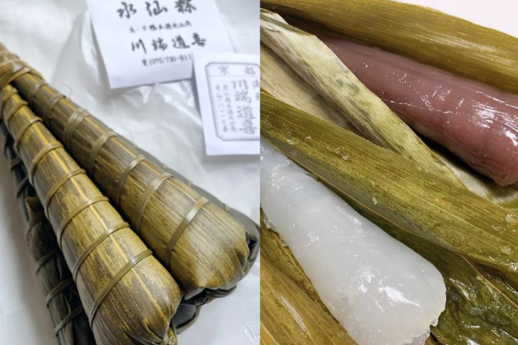2025.06.12
宙ちゃんの「伝統文化一直線」宙ちゃんの「伝統文化一直線」第19回 老舗は裏切らない
近藤宙時=日本伝統文化検定協会理事

川端道喜のちまき
昔、ファッション誌の特集に付いた「ブランドは裏切らない」というタイトルに、なんて上手なコピーだろうと感心したことがあります。同時に、日本に世界的ブランドがないのを残念に思ったものです。が、しばらく考えて、得心がいきました。
100年を超える歴史を持つ老舗は、どうしても次の100年を考えた経営をします。東京の都心に大型のショッピングビルを造っていた大手デベロッパーが、京都の老舗に出向いて出店を依頼した時のこと。返ってきた言葉に絶句したそうです。主人いわく「そのビルは100年後、200年後もありまっしゃろか」
こういう感覚の経営では、顧客の期待を裏切ることは絶対にできません。少しでも手を抜けば、評判が落ちます。間違っても売り逃げのようなまねはできません。店の規模にも、おのずと限界があります。「客を裏切らない」と納得できるものは、需要があるからといって、すぐには量産できないからです。主人の厳しい目の届く範囲でしか作れないし、売ることもできません。
自ら需要を喚起し、拡大し続ける世界的ブランドになるのは、このような経営では困難なことは想像に難くありません。攻めには、どうしても危険が付きまといます。「家を守る」「名を惜しむ」という意識こそが、日本の老舗のブランド化を阻んできたのでしょう。同時に、その意識こそが日本を稀有な老舗大国にしたのだと思います。
実際、老舗の定義を「創業200年以上の企業」とすると、日本には1388社もあるそうです。全世界の200年企業の数は2129社といいますから、なんとその3分の2が日本にあるのです(出典:日経BPコンサルティング・周年事業ラボ「2022年版世界の長寿企業ランキング」)。
江戸時代には、誰もが20年に1度は焼け出されるほど火事が頻発しました。地震も多く、宝永、安政、そして大正時代には大地震にも見舞われました。また明治維新、太平洋戦争と、幾度も社会システム全体がガラリと変わった激動期もありました。そうした苦難を老舗企業が乗り越えてきたことに思いをはせると、感動すら覚えます。ちなみに200年企業数の第2位は265社のアメリカ。建国から250年ほどしかたっていないアメリカは、産業の歴史から見ると立派な老舗大国になっています。
あまたの苦難を乗り越えてきた老舗たちが、日本の伝統文化の幅広さ、奥深さの一翼を担ってきたことは説明するまでもないでしょう。とりわけ、創業3年以内に7割が倒産するといわれるほど浮き沈みの激しい飲食・菓子業界で100年、200年以上も暖簾(のれん)を守ってきた老舗は、それだけで貴重な存在です。「元祖」と呼ばれる店も多く、誰でも気軽に伝統の味を楽しむことができます。
例えば、中国から渡ってきた肉饅頭(まんじゅう)から甘い餡(あん)を使った饅頭を考案した塩瀬総本家(東京都中央区)は1349年の創業。それまでの蒸し羊羹(ようかん)ではなく、現在主流となった練り羊羹を初めて世に出した総本家駿河屋善右衛門(和歌山市)は室町時代に創業しています。同じ室町時代の創業の川端道喜(かわばたどうき、京都市)は、葛(くず)を使った団子を笹(ささ)で巻いた和菓子としての粽(ちまき)を生み出しました。また、串に刺した団子の元祖と言える一文字屋和輔(いちもんじやわすけ、通称「一和」、京都市)に至っては、平安時代の西暦1000年創業と伝わり、世界で最も古い飲食店といわれています。
料理はもともと誰の家でも作っていましたから、古くからある日本料理で起源が分かるものはあまりありませんが、幕末・明治以降の創業になると、肉食・洋食の導入に伴い、牛鍋の太田なわのれん(横浜市)、牛肉水炊きの十二段家(京都市、料理名としての「しゃぶしゃぶ」は大阪市の永楽町スエヒロ本店が考案)、トンカツの煉瓦亭、ジャガイモを使ったコロッケのチョウシ屋、「あんぱん」の銀座木村家(以上東京都中央区)、ドリア、ナポリタン、プリンアラモードを生んだホテルニューグランド(横浜市)など、枚挙にいとまがありません。
また、「日本で初めて」というと、フランス料理の上野精養軒(東京都台東区)、イタリアンではホテルイタリア軒(新潟市)、本格的インドカレー専門店のナイルレストラン(東京都中央区)などが現在も営業を続けています。
グルメランキングに載る店を巡ったり、新しい料理やお菓子を求めたりするのも楽しいものですが、幾多の危機を乗り越え、長い歳月という得難い味わいを加えた元祖、老舗が作る食べ物には、日本の伝統文化を五感全てで堪能させてくれるものがあります。一度はご賞味いただきたいと願います。
【English version】
chu-chan's ‘Traditional Culture in a Straight Line’ No. 19: Long-established businesses do not betray us
KONDO Chuji = Director of the Japan Traditional Culture Certification Association.

Chimaki by Douki Kawabata
I used to be impressed by the title of a fashion magazine feature, ‘Brands don't betray you’, and thought what a good copy it was. At the same time, I regretted the lack of world-class brands in Japan. But after thinking about it for a while, I came to an understanding.
Long-established businesses with a history of more than 100 years inevitably manage their businesses with the next 100 years in mind. When a major developer building a large shopping building in central Tokyo visited a long-established business in Kyoto and asked them to open a shop. He was immensely surprised by the words he received in reply. The owner said, ‘I wonder if that building will still be there 100 or 200 years from now.’
In this kind of management, it is absolutely impossible to disappoint customers. If you cut corners, even a little, your reputation will be damaged. You cannot make the mistake of selling out. There are natural limits to the size of a shop. The reason is that you can't immediately mass produce what you are convinced will not betray your customers, just because there is a demand for it. They can only be made and sold within the strict control of their masters.
It is not difficult to imagine how difficult it would be for such a business to become a global brand that continues to stimulate and expand its own demand. Aggression inevitably entails risks. It is this sense of ‘protecting the house’ and ‘sparing the name’ that has probably prevented long-established Japanese companies from becoming brands. At the same time, it is this awareness that has made Japan a rare country with a large number of long-established businesses.
In fact, if we define long-established companies as those that have been in business for 200 years or more, there are 1,388 such companies in Japan. The number of 200-year-old companies worldwide is said to be 2129, which means that two-thirds of them are in Japan (Source: Nikkei BP Consulting, Anniversary Business Lab, ‘Longevity Company Ranking of the World in 2022’).
During the Edo period, fires were so frequent that everyone was burnt out once every 20 years. Earthquakes were also frequent, and the city suffered major earthquakes in the Hoei, Ansei and Taisho periods. There were also turbulent times when the whole social system changed completely, such as the Meiji Restoration and the Pacific War. It is even inspiring to think about how long-established companies have overcome such hardships. Incidentally, the second largest number of 200-year-old companies is 265 in the USA. The USA, which was founded only 250 years ago, has become an admirable long-established country in terms of its industrial history.
It is needless to say that long-established businesses that have overcome many hardships have played a role in the breadth and depth of traditional Japanese culture. Especially in the ups and downs of the food, beverage and confectionery industries, where 70% of businesses go bankrupt within three years of establishment, long-established businesses that have kept the goodwill for more than 100 or 200 years are valuable in their own right. Many shops are called “original” shops, where anyone can enjoy the traditional taste.
For example, Shioze Sohonke (Chuo-ku, Tokyo) was founded in 1349 and invented steamed buns with sweet red bean paste from the meat buns that came from China. Sohonke Surugaya Zen-emon (Wakayama City) was founded in the Muromachi period (1336-1573) and was the first to introduce kneaded yokan, which has now become mainstream, instead of steamed yokan. Kawabata Tauki (Kyoto City), also founded in the Muromachi period, produced chimaki, a Japanese confectionery made from dumplings made from kuzu (kudzu) and wrapped in bamboo grass. Ichimonjiya Wasuke (Ichi-wa, Kyoto), the originator of dumplings on a skewer, is said to have been founded in 1000 AD during the Heian period and is said to be the oldest restaurant in the world.
As food was originally prepared in everyone's home, there are not many old Japanese restaurants whose origins can be traced back to the end of the Edo period or after the Meiji period, but with the introduction of meat and Western food, the Ota Nawa-noren (Yokohama City) for beef hot pot and the Junidan-ya (Kyoto City; ‘shabu-shabu’ as a name for the dish was introduced in Osaka City) for beef mizutaki were established in the late Edo period (1603-1868). The list goes on and on, including Bricklayer for tonkatsu (pork cutlets), Choshiya for croquettes made from potatoes, Ginza Kimuraya for anpan (all in Chuo-ku, Tokyo), and Hotel New Grand (Yokohama) for doria, Neapolitan and pudding a la mode.
Other “firsts” in Japan that are still in business include the French restaurant Ueno Seyoken (Taito-ku, Tokyo), the Italian restaurant Hotel Italiaken (Niigata City) and the Nile Restaurant (Chuo-ku, Tokyo), which specialises in authentic Indian curry.
While it is fun to visit restaurants that appear in gourmet food rankings and to seek out new dishes and sweets, there is something about the food prepared by the originators and long-established restaurants, which have overcome many crises and added the unforgettable flavour of longevity, that makes traditional Japanese culture a delight for all five senses. We hope you will try them at least once.
カテゴリー: 宙ちゃんの「伝統文化一直線」
関連タグ: #和菓子





